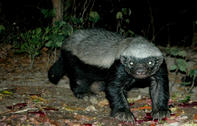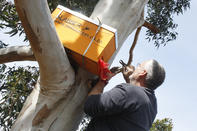The Honey Badger (Mellivora capensis) is a tough, thick-skinned weasel, which is also why one of South Africa’s first Infantry Combat Vehicles took its name from the Afrikaans name of this creature, Ratel.

Eagles, however, are scavengers, so they often feed on dead animals. During the lambing season, they may even wait for an ewe to finish lambing to scavenge the afterbirth. Verreaux (Aquila verreauxii) or black eagles are normally found along mountain ranges and rocky outcrops throughout Africa.
These jet-black birds have yellow feet, a sharp hooked bill and a white V on their backs and rumps. Adult birds are 78 cm to 90 cm long, with a wingspan of 181 to 219 cm. They built their nests on cliff ledges or boulders, using the same nests for many years. Martial eagles (Polemaetus bellicosus) are the largest eagle species in Africa, primarily found in open country and bushveld.
Their nests consist of large stick structures built under the canopies of tall trees. The adult birds have brown upperparts and a short dark crest. The underparts are white with brown with black spots that extend to feathered legs. The bill is strongly hooked and black, while the toes are bluish grey with large curved talons.
Adult birds are 78 to 96 cm long with a wingspan ranging between 188 to 260 cm. Rock dassies (hyrax) comprise about 90% of a Verreaux eagle’s diet, while hares, rock dassies, leguaan and game birds comprise the main supply in the martial eagle’s diet.
Killing and Feeding Pattern

Honey badgers are opportunistic carnivores, with anything smaller than themselves being considered prey, from insects to young crocodiles. They are primarily hunters, but may also scavenge or steal food from other animals and rubbish bins.
They are most active at night during the warm summer months and in the day-time during the colder winter months. In areas where they are not disturbed, they are usually most active early in the mornings and late afternoons. Rogue individuals occasionally kill small livestock, with poultry, sheep and goats being the main targets.
Honey badgers seldom kill the prey before they eat, but instead eat holes into the prey and sometimes even tear limbs off while the prey is still alive. Only small quantities of the flesh are taken, usually meat from the face, such as the nose, cheek muscles or tongue. Prey is usually ripped open from below, with a large hole in the chest cavity.
Management

Honey badgers are listed as a protected species in South Africa. Farmers need a permit to kill or move honey badgers. Honey badgers are good diggers and have extremely strong front claws, which enable them to easily tear through wire netting.
Kraaling, shepherds and guard animals are therefore the best methods to prevent losses. The Badger Friendly Label was developed to indicate the production of honey in a way that does not harm badgers. Honey producers achieve this by raising their hives a few metres from the ground out of the honey badgers’ reach, by for example strapping the hives to poles.
According to the South African National Biodiversity Institute and Endangered Wildlife Trust, damages caused by honey badgers have declined by about 66% between 2001 to 2009, because of improved hive protection methods.
By Glenneis Kriel